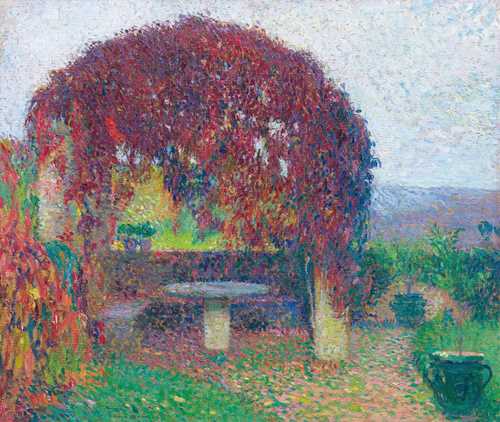
拍品 3227* - A197 印象派&现代主义 - Freitag, 02. Juli 2021, 05.00 PM
HENRI MARTIN
(Toulouse 1860–1943 Labastide-du-Vert)
Pergola Nord-Ouest de Marquayrol en fin d'automne. 1910–20.
Oil on canvas.
Signed lower left: Henri Martin.
68.5 × 82 cm.
The authenticity of the work has been confirmed by Cyrille Martin, Neuilly-sur-Seine, 12 January 2017.
Provenance:
- Galerie Félix Vercel, Paris.
- Private collection, Caracas, acquired from the above gallery on 25 May 1971.
- Private collection, Germany.
In 1900, after 10 years of searching for the perfect country house, Henri Martin acquired the large 17th-century house Marquayrol in the village of Labastide-du-Vert in Lot in southwestern France when he was 40 years old. The house and the region became Martin's summer holiday destination, where he withdrew from the city of Paris between May and November to enjoy the serenity of nature.
The house, sitting on a hill with a large terrace and a view of the village and the surrounding valley, became Martin's most important source of inspiration and had a lasting influence on his style. There, unlike in Paris, a southern light reigned, which inspired the artist and stimulated his eye. The peaceful environment, together with nature and light, became Martin's preferred subject and would remain so for more than 40 years. "This move to Lot at the age of 40 marks a decisive turning point in his artistic work. Muses and lyres disappear from his canvases and he dares to grapple daily with the light of the south" (Juskiewenski 1993, p. 98).
On both sides of the property there was an arbor, a small pergola, "la petite", and a larger one, "la tonnerelle". The present work, which was produced in the 1920s and is a fine example of Martin's mature style, depicts the large pergola "la tonnerelle". Martin repeatedly took up the depictions of the pergola during the entire summer, so that the colours of the leaves change in the course of the picture cycle. The autumnal red that dominates our picture symbolises the end of summer and Martin's imminent return to Paris.
“Henri Martin was undoubtedly an Impressionist and one who possessed the deepest sensitivity, which certainly corresponded to that of Monet, whom he admired the most. Thanks to their extreme sensitivity and not through the investigation of a technical process, their interpretation of nature is certainly a poetic evocation coloured by a thousand colours […] His palette is an enchantment. Many different blends of colours produce a rare and rich harmony. […] And it is much more difficult to find a good harmony of colours when one represents nature than to put together some beautiful colours that do not represent anything. Herein lies the gift of the Impressionists, and that is why there are so few” ( Martin-Ferrières 1967, p. 35–42).
Provenance:
- Galerie Félix Vercel, Paris.
- Private collection, Caracas, acquired from the above gallery on 25 May 1971.
- Private collection, Germany.
In 1900, after 10 years of searching for the perfect country house, Henri Martin acquired the large 17th-century house Marquayrol in the village of Labastide-du-Vert in Lot in southwestern France when he was 40 years old. The house and the region became Martin's summer holiday destination, where he withdrew from the city of Paris between May and November to enjoy the serenity of nature.
The house, sitting on a hill with a large terrace and a view of the village and the surrounding valley, became Martin's most important source of inspiration and had a lasting influence on his style. There, unlike in Paris, a southern light reigned, which inspired the artist and stimulated his eye. The peaceful environment, together with nature and light, became Martin's preferred subject and would remain so for more than 40 years. "This move to Lot at the age of 40 marks a decisive turning point in his artistic work. Muses and lyres disappear from his canvases and he dares to grapple daily with the light of the south" (Juskiewenski 1993, p. 98).
On both sides of the property there was an arbor, a small pergola, "la petite", and a larger one, "la tonnerelle". The present work, which was produced in the 1920s and is a fine example of Martin's mature style, depicts the large pergola "la tonnerelle". Martin repeatedly took up the depictions of the pergola during the entire summer, so that the colours of the leaves change in the course of the picture cycle. The autumnal red that dominates our picture symbolises the end of summer and Martin's imminent return to Paris.
“Henri Martin was undoubtedly an Impressionist and one who possessed the deepest sensitivity, which certainly corresponded to that of Monet, whom he admired the most. Thanks to their extreme sensitivity and not through the investigation of a technical process, their interpretation of nature is certainly a poetic evocation coloured by a thousand colours […] His palette is an enchantment. Many different blends of colours produce a rare and rich harmony. […] And it is much more difficult to find a good harmony of colours when one represents nature than to put together some beautiful colours that do not represent anything. Herein lies the gift of the Impressionists, and that is why there are so few” ( Martin-Ferrières 1967, p. 35–42).
CHF 80 000 / 120 000 | (€ 82 470 / 123 710)
以瑞士法郎銷售 CHF 97 900 (包含買家佣金)
所有信息随时可能更改。


